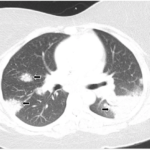Background & Objectives The ORAL Surveillance trial (NCT02092467), a postauthorization safety study of tofacitinib in patients with rheumatoid arthritis (RA) aged 50 years or older with at least one additional cardiovascular risk factor, found a dose-dependent increase in venous thromboembolism (VTE) and pulmonary embolism (PE) events when patients were treated with tofacitinib vs. a tumor…
Search results for: pulmonary embolism

Case Report: Pulmonary Sarcoid-Like Reaction in Patient Treated with Etanercept
Sarcoidosis is a multisystem disease characterized by noncaseating granulomas in affected tissues, mostly involving the lungs and lymph nodes.1,2 The etiology of sarcoidosis remains unknown but is thought to be due to an inflammatory response to an antigen exposure in genetically predisposed individuals.1 Tumor necrosis factor-α (TNF‑α), a pro-inflammatory cytokine, plays an essential role in…

Janus Kinase vs. TNF Inhibitors: The Context for Venous Thromboembolism Risk with RA Treatments
An observational study found treatment with tofacitinib resulted in only a slightly higher rate of venous thromboembolism than tumor necrosis factor inhibitors in patients with rheumatoid arthritis.

Catastrophic Antiphospholipid Syndrome with Pulmonary Hemorrhage: A Case Report
Antiphospholipid syndrome (APS) is an autoimmune condition characterized by hypercoagulability often manifested as recurrent thrombosis or pregnancy complications, with persistently circulating antiphospholipid (aPL) antibodies or lupus anticoagulant. Catastrophic APS (CAPS), also known as Asherson syndrome, occurs in less than 1% of cases of APS and involves occlusive microangiopathy in at least three organ systems.1 Case…

Safety Risk with Higher Dose Tofacitnib
According to the FDA, an ongoing safety trial found higher dose tofacitinib increased the risks of pulmonary embolism and death in RA patients…

15,000 Patient-Years: Safety Data for Upadacitinib Treatment Across Multiple Rheumatic Conditions
Burmester et al. characterized the long-term safety profile of upadacitinib treatment across multiple rheumatic diseases.

Case Report: Diaphragm Ultrasound Reveals Shrinking Lung Syndrome
Shrinking lung syndrome (SLS) is a rare cause of dyspnea that has been most commonly described in patients with systemic lupus erythematosus (SLE), but is also found in systemic sclerosis, Sjögren’s disease and rheumatoid arthritis. Shrinking lung syndrome is characterized by a restrictive pattern on lung spirometry, despite normal lung parenchyma, and an elevated diaphragm.1…

Pediatric Clinical Year in Review: 2023
SAN DIEGO—Too many excellent pediatric rheumatology studies to squeeze into one talk? What a good problem to have. Dr. Ardoin first highlighted baricitinib in juvenile idiopathic arthritis.

Infertility 101: What Every Rheumatologist Should Know
Infertility is a frequently encountered issue in medicine, seen in about 9% of men and about 11% of women of reproductive age in the U.S.1 Many rheumatologists may not be aware of the prevalence of infertility and the implications this issue may have on the care of their patients. Here, Anat Chemerinski, MD, instructor in…

Case Report: A Patient Presents with Digital Ischemia & Gangrene
Defined by the presence of antiphospholipid antibodies (aPL) in individuals with clinical evidence of thrombosis or pregnancy morbidity, antiphospholipid syndrome (APS) is a systemic autoimmune thrombophilia. Clinical thrombosis, which should be confirmed by objective validated criteria (e.g., imaging studies or histopathology), can occur in the arterial, venous or small vessel vasculature and is not limited…
- 1
- 2
- 3
- …
- 7
- Next Page »